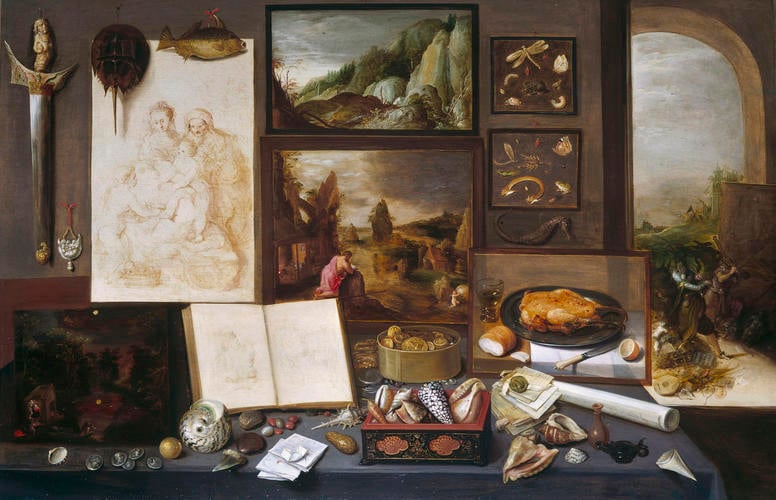-
1 of 253523 objects
The Cabinet of a Collector Signed and dated 1617
Oil on panel | 76.7 x 119.1 cm (support, canvas/panel/stretcher external) | RCIN 405781

Frans Francken the Younger (Antwerp 1581-Antwerp 1642)
The Cabinet of a Collector Signed and dated 1617
-
Frans Francken the Younger was the most famous of an Antwerp dynasty of painters; he trained with his father, Frans the Elder (1542-1616), and joined the Antwerp guild in 1605. He was a painter of religious and historical subjects as well as being the inventor of the genre presented here, the cabinet painting.
Collectors throughout Europe tended to keep their most prized and smaller possessions in a small private study, called a ‘cabinet’ in French and English (sometimes ‘cabinet of curiosities’ or ‘varieties’); in Italian it might be called a Gabinetto, Studiolo or Camerino; in German a Kunst-, Schatz- or Wunderkammer. These spaces tend to be packed (rather than arranged) with paintings, objets d’art and natural curiosities. The crucial word here is ‘curiosity’; such collections were formed to stimulate intellectual curiosity, in every branch of human enquiry, as well as providing aesthetic pleasure. The English theorist of natural philosophy, Francis Bacon (1561-1626), recommended in 1595 that a learned gentleman should have a ‘goodly, huge cabinet, wherein whatsoever the hand of man by exquisite art or engine has made rare in stuff, form or motion; whatsoever singularity, chance and the shuffle of things hath produced; whatsoever Nature has wrought in things that want life and may be kept; shall be sorted and included’ (Bacon, Gesta Grayorum).
This assemblage includes a landscape by Joos de Momper (1564-1635); a still life of a mundane table set for a meal; and a small, nocturnal Flight into Egypt. The other religious painting deals with the subject of human enquiry; St Augustine is trying to comprehend the idea of the Trinity and sees a baby struggling to pour the entire sea into a pool in the sand with a shell - both tasks being equally beyond the compass of man. The drawings - two studies for Michelangelo’s Sistine ceiling and a preparatory drawing for Raphael’s Madonna della Perla (Prado, Madrid) - stress the intellectual side of painting. The two ‘specimen paintings’ depicting a range of fauna, including an impossible two-headed eel, connect the works of art with the natural curiosities - shells, stones and stuffed fish. There are also letters, perhaps suggesting the exchange of scholarly opinion; exotic weaponry a reminder of the importance of travel and trade; a handful of Roman coins and a bowl of modern ones, probably included to celebrate the achievements of great men, rather than as currency.
The most interesting passage occurs beneath the arch to the right: in the background a church is demolished and nearby donkey-headed fops with cudgels destroy a pile of objects associated with learning, science, the arts and sport. According to van Mander, a man with a donkey head is a symbol of Ignorance. The episodes depicted here recall two historical events: the Beeldenstorm, an outbreak of iconoclasm carried out by Protestants in 1566; and the ‘Spanish Fury’, the sack of Antwerp in 1576. It is interesting that for Frans Francken the sin of the donkey-heads is not sacrilege (the iconoclast’s sin in the eyes of Roman Catholics) or anger (or whatever other sin might be ascribed to violent Spanish soldiery) but stupidity. As Schiller later observed, 'Against stupidity, the Gods themselves contend in vain'. One of the coins bears the names of the Archdukes Albert and Isabella, the rulers of the southern Netherlands at this time of the Twelve Years’ Truce (1609-21); the painting would seem to celebrate the wisdom of their rule, which can allow curiosity to flourish and keep Ignorance at bay.
Signed and dated on the large scroll, lower right: f. franck Inventor/ Ao 1617
Catalogue entry adapted from Bruegel to Rubens: Masters of Flemish Painting, London, 2007Provenance
Acquired by George III in 1762 as part of the collection of Joseph Smith, British Consul in Venice (Dutch and Flemish List, no 55)
-
Medium and techniques
Oil on panel
Measurements
76.7 x 119.1 cm (support, canvas/panel/stretcher external)
96.9 x 140.0 x 4.2 cm (frame, external)
Category
Object type(s)
Other number(s)
Alternative title(s)
Cabinet of Virtuoso, previously entitled
Still life, shells, etc, previously entitled